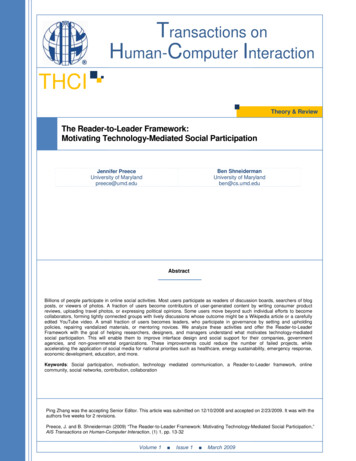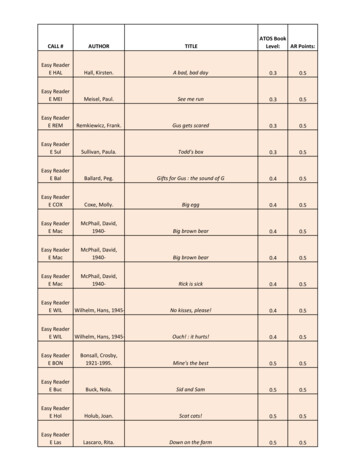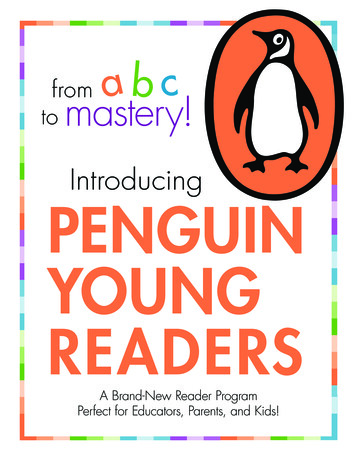
Transcription
Transactions onHuman-Computer InteractionTHCITheory & ReviewThe Reader-to-Leader Framework:Motivating Technology-Mediated Social ParticipationBen ShneidermanUniversity of Marylandben@cs.umd.eduJennifer PreeceUniversity of Marylandpreece@umd.eduAbstractBillions of people participate in online social activities. Most users participate as readers of discussion boards, searchers of blogposts, or viewers of photos. A fraction of users become contributors of user-generated content by writing consumer productreviews, uploading travel photos, or expressing political opinions. Some users move beyond such individual efforts to becomecollaborators, forming tightly connected groups with lively discussions whose outcome might be a Wikipedia article or a carefullyedited YouTube video. A small fraction of users becomes leaders, who participate in governance by setting and upholdingpolicies, repairing vandalized materials, or mentoring novices. We analyze these activities and offer the Reader-to-LeaderFramework with the goal of helping researchers, designers, and managers understand what motivates technology-mediatedsocial participation. This will enable them to improve interface design and social support for their companies, governmentagencies, and non-governmental organizations. These improvements could reduce the number of failed projects, whileaccelerating the application of social media for national priorities such as healthcare, energy sustainability, emergency response,economic development, education, and more.Keywords: Social participation, motivation, technology mediated communication, a Reader-to-Leader framework, onlinecommunity, social networks, contribution, collaborationPing Zhang was the accepting Senior Editor. This article was submitted on 12/10/2008 and accepted on 2/23/2009. It was with theauthors five weeks for 2 revisions.Preece, J. and B. Shneiderman (2009) “The Reader-to-Leader Framework: Motivating Technology-Mediated Social Participation,”AIS Transactions on Human-Computer Interaction, (1) 1, pp. 13-32Volume 1 Issue 1 March 2009
Preece & ShneidermanThe Reader-to-Leader FrameworkINTRODUCTIONYouTube, whose 10 billion video views per month makes it the third most active website in the world, has become thelocation of choice to present personal videos, new product demos, and political agendas. Wikipedia, which has morethan 10 million articles in 250 languages, has risen to be one of the top ten websites in the world. Facebook,MySpace, LinkedIn, and other social networking sites are expected to grow to 1 billion participants by 2012 (Alexa,2009). Cell phone, text messaging, and mobile versions of web services will soon exceed 3 billion users across theworld. Billions of people contribute knowledge and opinions through wikis, discussion forums, and blog communities,while others build collective intelligence by tagging photos, rating movies, reviewing restaurants, and commenting onpolitical events. These social applications have grown immensely in the past 10 years, but still newer innovations mayovertake them. Twitter, Jaiku, and other microblogging services enable friends to read about each other’s activities,teens to track celebrities, families in fire-ravaged regions to scan updates from loved ones, and firefighters to keeptrack of their colleagues as they fight the fires.This paper presents the Reader-to-Leader Framework, which describes how people often join social media by firstreading, then marginally contributing by sending a brief note, asking a question, uploading a photo, or rating arestaurant. Some may go on to collaborate with others on a Wikipedia article or YouTube video, or they may take on aleadership role in a discussion or by helping newcomers.This framework, supported by extensive references to the research literature, is designed to help researchers,designers, and managers understand what motivates technology-mediated social participation. This will enable themto improve interface design and social support for their companies, government agencies, and non-governmentalorganizations. These improvements could reduce the number of failed projects, while accelerating the application ofsocial media in healthcare, energy sustainability, emergency response, economic development, education, and more(Shneiderman and Plaisant, 2009; Ye and Fischer, 2007).The next section discusses the social and cultural background in which social media are used. The third sectionintroduces some of the theoretical concepts that underpin the Reader-to-Leader Framework. The fourth sectionsummarizes the discussion and suggests a research agenda for testing the framework.BACKGROUNDUsers can find anything being promoted, discussed, or tagged on the Internet, whether it is consumer products,scientific ideas, youthful infatuations, or terrorist agendas (Wellman and Gulia, 1999). Some online social connectionsare lightweight and ephemeral; some involve regular contributions; some continue online as stable collaborations thathave shared purposes; and some lead to life-altering, durable, relationships that often involve face-to-face meetings.Participants who deepen their commitment by making repeated contributions or significant collaborations may growloyal to their social connections and take on leadership efforts to strengthen their community by fixing problems(software or content), or by mentoring novices and contributing to governance.The culture of the Internet is about much more than information transfer. It has become increasingly social andcommunal. The purpose of mobile devices such as cell phones has expanded beyond person-to-personcommunication to become the facilitator of the rich social web. While individuals’ needs and characteristics initiallyshape interface designs, increasingly, social requirements determine the nature of technology-mediatedcommunication (Moore and Serva, 2007). For example, many millennials – the name given to technically-savvypeople under the age of 30, born between the years 1978-1996 in developed countries – use email but prefer cellphone texting and communicating via Facebook (New Politics Institute, 2007). Twitter, too, is growing in popularitywith some in this age group, as it provides a steady feed of awareness information about the hundreds of people theymight follow (Wu et al., 2008). Stimulated by the need to share communications tools and to leap over the expensivelaptop culture that depends on thick Internet “pipelines,” users and businesses in many parts of the world seek lessexpensive solutions that support cooperatives and microfinanced entrepreneurs. Consequently, cell phones and othermobile devices are becoming the norm across the world, vastly outnumbering web-connected laptops (Lasica, 2008).New ways of creating and maintaining familiar applications that exploit social opportunities are emerging. OpenSource software has had many successes, but now citizens are sharing skills to create numerous other services. Afew years ago, it was hard to imagine that Jimmy Wales’ dream of creating a continuously updated onlineencyclopedia free of charge, would become a highly respected and frequently consulted information sourceTagging taps into the previously inaccessible knowledge of individual citizens and creates a sense of community, asamong the virtual museum goers of the Steve Museum project, a cultural heritage database (Trant et al., 2007).AIS Transactions on Human-Computer InteractionVol. 1, Issue 1, pp.13-32, March 200914
Preece & ShneidermanThe Reader-to-Leader FrameworkUsing more elaborate commenting techniques, doctors and nurses share knowledge that helps save lives acrossremote areas of the world.For all the public and corporate enthusiasm and the proclamations of utopian visionaries, the reality is that many websites fail to retain participants, tagging initiatives go quiet, and online communities become ghost towns. Manygovernment agencies are reluctant to even try social participation, fearing public uprising, pornography, or slander.Many social applications just aren’t social at all and see little or no activity (Preece, 2000).While discretionary use of playful social applications can be successful, there are fewer stories about durable largescale successes that deal with difficult issues such as crime reporting, disaster response (Shneiderman and Preece,2007; Torrey et al., 2007), large scale epidemics such as AIDS, or fighting terror. Even personal health reportingwebsites from Google and Microsoft or the innovative PatientsLikeMe have drawn relatively few participants. AmberAlert can claim modest success in recovering abducted children, but there are many other problems in developedcountries that could benefit from more social participation. Similarly, in developing nations, where leaders arestruggling to achieve the United Nations Millennium Development Goals, effective social media could be helpful to aidworkers, government project directors, and local entrepreneurs (Perry, 2000). Responses to many of the world’sdifficult challenges could be dramatically more successful if social participation could be made more consistentlyeffective.Unfortunately, the potency of technology-mediated social participation has been recognized by terrorists, religiousextremists, and criminal organizations (Taylor et al., 2006; Simon Wiesenthal Center, 2008). Furthermore, the volumeand detail of information in these social participation applications poses a severe threat to privacy. However, if publicsafety officials, civic-minded technology specialists, and well-intentioned citizens devote sufficient attention to thepotential for misuse, it can be reduced.Researchers, designers, and managers want to learn from successful applications and to apply this knowledge in thedesign and management of applications that they care about. A unified theory that could be applied across a range ofapplications and social contexts would be useful, but such a theory is elusive and may not be possible. However,some researchers in the field of motivation have admirably applied their work to sociotechnical systems. For example,Zhang (2008a, 2008b) draws on research by Reeve (2005), Norman (2004), and others to explain the impact of ICTdesign and to suggest guidelines. Wu develops a model of motivation to explain students’ adoption of a universityemergency response system (Wu, 2009). Further, Benkler and Nissenbaum (2006) advocate “virtue” in an articleentitled “Commons-based peer production and virtue.” These authors draw deeply on philosophy, supported byobservations, and posit: “(a) that a society that provides opportunities for virtuous behavior is one that is moreconducive to virtuous individuals; and (b) that the practice of effective virtuous behavior may lead to more peopleadopting virtues as their own, or as attributes of what they see as their self-definition” (Benkler and Nissenbaum,2006, p. 394). Researchers frequently invoke theories relating to a range of social behavior to explain theeffectiveness of design components that support reputation development, offer rewards, encourage altruism, and soforth. Many of these are addressed later in this paper.The literature contains several examples of frameworks or models, underpinned by appropriate theory, that describehow people’s online behavior changes over time. Some observant developers advocate models derived throughpractices that have similar components to the Reader-to-Leader Framework, except that few attempts have beenmade to relate their stages to theory and current research. For example, Porter’s (2008) Funnel Model identifies fourtypes of user behavior--interested, first-time use, regular-use, passionate-use--and the relative decrease inparticipation from 100 percent, to 30, to 20, to 2 that respectively tends to occur at each stage. Kim (2000) alsoproposed a version of a funnel model. Li and Bernoff (2008) develop a technique known as “social technographicsprofiling,” which uses the results of large-scale surveys, typically involving 10,000 users. Using the data, they draw upprofiles of online behavior. Both Porter’s and Li and Bernoff’s approaches provide a basis for research that wediscuss in the next section. By distilling scientific literature, a goal of this paper is to provide a framework that enablesresearchers, designers, and managers to understand what motivates technology-mediated social participation.The next section presents the Reader-to-Leader Framework with four subsections that review research on readers,contributors, collaborators, and leaders. Based on this research, we make suggestions for motivating technologymediated social participation. In the final section, we discuss implications for researchers, designers, and managers.THE READER-TO-LEADER FRAMEWORKPeople typically start using their web and mobile devices to join a discussion group, read a blog, or tag a photo.Many decide that one look is enough to satisfy their curiosity, but a few decide to return to an application a second orthird time, and some even start to contribute (Forte and Bruckman, 2008a) Usually, new users begin by doing simplethings—they may edit an incorrectly spelled word or agree with someone else’s comment –that don’t take much effortor require them to expose themselves. Metaphorically, they dip their toe in. A few of these people return and beginAIS Transactions on Human-Computer InteractionVol. 1, Issue 1, pp.13-32, March 200915
Preece & ShneidermanThe Reader-to-Leader Frameworkparticipate more actively.The successive levels of social participation that we are concerned with can roughly be categorized as reading,contributing, collaborating, and leading. These are not perfect or complete descriptions, and users don’t alwaysprogress from one to another, but this simple framework is a useful basis to describe what many users do (Figure 1).The thickness of the green arrows and smaller shapes indicate the decreasing number of people who move from oneform of participation to another. The thin grey arrows indicate how people can also move in a non-linear fashion toparticipate in different ways.Figure 1: The Reader-to-Leader Framework: Motivating technology-mediated social participation. As usersbecome aware of social media they become readers. Some will become contributors, then collaborators, andpossibly leaders.In addition to making these transitions to greater participation, many people terminate their participation for a varietyof reasons, which is not shown explicitly in Figure 1. There is also a time dimension within the four activities. For eachactivity, there are the uncertain first steps, sometimes followed by repeat visits that can mature into a growing senseof confidence and increased activity as a reader, contributor, collaborator, or leader. There are at least two paths tomaturation: participants may become more active within one stage or may move on to begin another stage.Reader: Venturing in, reading, browsing, searching, returningCreating awareness of social media can be done with an expensive advertising campaign, but an attractivealternative is word of mouth, amplified by word of blog, online reviews, testimonials from celebrities, and links frompopular portals (Porter, 2008). Another important source of novice participants is from search engine results andmedia stories, especially in prominent media (Porter, 2008; Li and Bernoff, 2008; Fogg, 2002). Spreading the wordabout novel social media is a skill that must be mastered to draw in potential readers to try something new. For somepeople, overcoming their resistance to novelty may require strong encouragement from a trusted friend or respectedauthority (Fogg, 2002), while others embrace new experiences. But in a world of many choices, designers will dobetter if they create interesting, attractive, and relevant content (Kim, 2000). This may seem obvious, but getting itright is more difficult than it sounds. Rogers (2003) points out, for example, that innovation is more likely to beaccepted if the value of the material is clear to potential users. Figure 2 shows how design features have beenincorporated into the home page of the Encyclopedia of Life (2009) to describe the goal of the site, make it attractive,indicate new content, and provide help.Swarming crowds of readers visit online discussions on topics that range from athletics to zoology, with media thatrange from text-only microblogs, to blogs and discussion boards, to photo and video sharing communities. Good userinterface design produces accessible and universally usable applications that enable solitary reading or socialinteractions that meet the needs of diverse user populations (Rainie and Tancer, 2007). For example, childrenbetween the ages of seven and nine tend to have a limited vocabulary, and many don’t like to read a lot, so interfacesthat contain pictures and encourage them to draw tend to be popular (Komlodi et al., 2007). Similarly, softwaredesigned for early teens such as Habbohotel.com must appeal to that user group. Figure 3 shows howHabbohotel.com allows teens to control their own identities by selecting clothes and hairstyles for their avatars. Bothage and gender tend to influence what children like to do in online social spaces (Komlodi et al., 2007).Good interface design should facilitate discovery of relevant content by browsing and by search, with easymechanisms to bookmark, print, email, tag, privately annotate, and publicly comment on interesting items (Fischer,2007). Support mechanisms for readers include a summary of the intended audience, the purpose of the site,AIS Transactions on Human-Computer InteractionVol. 1, Issue 1, pp.13-32, March 200916
The Reader-to-Leader FrameworkPreece & Shneidermanimportant policies such as privacy protection, and flexible tools that support the community in developing its owngovernance structures, as in some wikis (Butler et al., 2008). Other helpful content includes contact information forsite managers, a statement of ownership, a list of Frequently Asked Questions (FAQ) with well-written answers(Hansen et al., 2007), indicators of new material, lists of popular items, and easy facilities for contacting friends(Porter, 2008). A major managerial decision is whether to require login for reading, which may be seen as a nuisanceby some and a valid protection by others (Preece et al., 2004). Charging a fee for reading is rare, but for servicesthat provide valuable information, this can be the major source of revenue.Figure 2: Encyclopedia of Life (2009) has attractive content that clearly describes its purpose and provides awelcome message and invitation to become involved.Reading user-generated content posted by other participants is a typical first step toward more active participation(Nonnecke and Preece, 2000; Preece et al., 2004; Yeow et al., 2006). While reading can be thought of as legitimateperipheral participation (Lave and Wenger, 1991), some researchers have coined the term “lurking” to describe thisand other activities that do not produce a visible contribution (Kollock, 1999).People may be enticed to adopt an artifact or practice if others they know and trust are already involved (Rogers,2003). This principle of trust transference can underpin social software applications, and it is being used increasinglyin social network applications (Golbeck, 2006, 2007).The most understandable motivation for people to read user-generated content is that they personally benefit fromdoing so. Most readers of health discussions, consumer product reviews, or Wikipedia articles presumably arelooking for information that they plan to use. Sometimes people may read to gain information that benefits others,such as family members, friends, or colleagues (Maloney-Krichmar and Preece, 2005). An equally powerfulmotivation is that reading blogs or viewing videos is fun.A successful first reading experience can generate positive word-of-mouth commentary that encourages othernewcomers, while a bad experience will discourage even a second visit. Getting return visitors is a major challengefor most social media managers as a majority of visitors do not return. However, some visitors become intenselyinvolved, returning dozens of times a day and becoming satisfied daily visitors for years. Regular readers come toAIS Transactions on Human-Computer InteractionVol. 1, Issue 1, pp.13-32, March 200917
Preece & ShneidermanThe Reader-to-Leader Frameworkrecognize active contributors, discriminate about the quality of contributions, and develop a strong sense of belongingto a community, even if they have limited personal contact with individuals in the community.Figure 3: Habbohotel.com – a community for early teens in which they can choose the gender of their avatarand then select different kinds of clothes and hair.New users need assurance that social media are safe. Harsh or sarcastic remarks deter participation, so clearpolicies are needed that assure participants that they are safe online (Beschastnikh et al., 2008). Other strategiesinclude providing “Getting Started” guides for new users to explain the application and the behavior that is expected(Kim, 2000) or setting up visitor and newcomer areas, such as sandboxes in wikis (Hansen et al., 2007). Trainingmanuals, video introductions, and personal mentoring are other ways to encourage participation, as is providing awindow so that onlookers can see discussions and other activities without going through a login procedure. This latterapproach is more likely to succeed than a link, particularly if that link is surrounded by other information that makes ithard to spot (Maloney-Krichmar and Preece, 2005).A critical mass of new content (Rainie and Tancer, 2007) and user interaction that engages but does not overwhelm(Cheng and Vassileva, 2005; 2006) helps to entice people to come back often. Making the effort to login, only to findthe same old messages or pictures, is annoying.To summarize, the factors discussed above can be grouped according to whether they influence usability orsociability. Usability factors are of most interest to designers, and sociability factors are of interest to communityparticipants, site owners, and managers. Some usability and sociability factors (Preece, 2001) that motivate readersfor technology-mediated social participation are included in Table 1.Table 1 Usability and sociability factors that may influence readingUsabilityInteresting and relevant content presented in attractive,well-organized layoutsFrequently updated content with highlighting to encouragereturn visitsSupport for newcomers through tutorials, animateddemos, FAQs, help, mentors, contactsClear navigation paths so that users have a sense ofmastery and controlUniversal usability to support novice/expert, small/largedisplay, slow/fast network, multilingual, and users withdisabilitiesInterface design features to support reading, browsing,searching, and sharingSociabilityEncouragement by friends, family, respectedauthorities, advertisingRepeated visibility in online, print, televisionand other mediaUnderstandable and clear norms or policiesA sense of belonging based on recognition offamiliar people and activitiesCharismatic leaders with visionary goalsSafety and privacyContributor: Rating, tagging, reviewing, posting, uploadingCuriosity is a wonderful human trait. People venture into online social media spaces looking for something –information, support, content, company or excitement. But it is challenging to get them to return a second, third, orfourth time and eventually to become a contributor. A contribution is an individual act that adds to a larger communaleffort--for example, adding a picture or a comment to a website--when there may be no intention of collaborating,AIS Transactions on Human-Computer InteractionVol. 1, Issue 1, pp.13-32, March 200918
The Reader-to-Leader FrameworkPreece & Shneidermancommunicating, or forming a relationship. Contributors often start by making a correction on a wiki, tagging aphotograph, or rating a film. This approach of modest first steps has been observed in open source softwaredevelopment, where people report bugs (Ye and Kishida, 2003), and in Wikipedia, where people make small edits(Schroer and Hertel, 2009; Bryant et al., 2005; Forte and Bruckman, 2008a, 2008b). In this way, people move fromlegitimate peripheral participation in which they hover on the sidelines reading content, watching others, to graduallymaking small contributions that become larger and more frequent as their confidence grows and they feel empoweredand appreciated (Lave and Wenger, 1991; Wenger, 1998).A design feature that promotes contributions is visibility to the author and community, possibly with the contributorbeing identified by a login name. This visibility offers contributors recognition that adds to their social presence online,which has been observed to motivate tagging in Flickr (Ames and Naaman, 2007; Nov et al., 2008) and to increaseediting contributions in Wikipedia (Nov, 2007), in turn, creating a growing reputation (Farzan et al., 2008).Some applications keep track of the most prolific contributors so that they can be seen and appreciated (Viégas andSmith, 2004) but quantity is only one virtue; quality of contribution can be even more important. For instance,Wikipedians who specialize in a certain topic become distinguished from those who make numerous small fixes. Intheir world, writing an article that gets chosen to be the daily featured article is among the highest achievements.Microsoft Discussion Groups cover hundreds of technical topics related to Microsoft products in dozens of languages.User-to-user assistance is a virtue in itself, but Microsoft recognizes the value to its customers by rewarding hundredsof Most Valuable Professionals (MVPs) each year with professional recognition that includes invitations to a face-toface event and free Microsoft products. This recognition also benefits the MVPs, since their visibility may get themconsulting contracts. Microsoft describes its review process:In order to receive the Microsoft MVP Award, MVP nominees undergo a rigorous review process. Technicalcommunity members, current MVPs, and Microsoft personnel may nominate candidates. A panel thatincludes MVP team members and product group teams evaluate each nominee's technical expertise andvoluntary community contributions for the past year. The panel considers the quality, quantity, and level ofimpact of the MVP nominee's contributions. Active MVPs receive the same level of scrutiny as othercandidates each year.Rating systems capitalize on a trend in popular culture -- people’s desire to stand out in a crowd. Reality shows;talent competitions; YouTube, blog, and microblog revelations of intimate personal details; and Flickr posts ofprovocative pictures are all manifestations of the need to be noticed. They also fuel and make real the belief thatanyone can be famous. Thus, acknowledging, recognizing, and rewarding contributions and, in so doing, enabling thecontributors to stand out (Hemetsberger, 2001; Kollock, 1999; Huffaker, 2007) are techniques used by researchersand designers (Kollock, 1999; Lampel and Bhalla, 2007; Kolbitsch and Maurer, 2006) to encourage onlinecontributions. One approach to providing recognition is to encourage others to rate the quantity or quality ofcontributions. These systems provide a way for people, including peers and complete strangers, to recognize andevaluate another’s contribution. Beginning with eBay’s popular rating system by which purchasers rate vendorsaccording to the condition of the goods purchased, the timeliness of delivery, the quality of the purchase, and so on,peer evaluation systems have proliferated (Cheng and Vassileva, 2005). Variations on this theme involve ratingpeople’s ratings (Cialdini, 2001), rewarding contributions with money (Hars and Qu, 2002; Hemetsberger, 2001;Kollock, 1999, Hummel et al., 2005), and awarding points in learning systems (Vassileva, 2003).In scientific communities, recognition as a reviewer, author, organizer, or mentor is essential to professionaladvancement and university promotion. In creative communities, the rewards might include winning art jury prizes orsimply gaining a strong reputation that comes with a high number of YouTube downloads (Fischer and Giaccardi,2006; Shneiderman, 2007). Outstanding contributors may receive much publicity in web-based, mobile, or traditionalmedia.Rating systems supported by credible information about those being rated can also be helpful. For example, Figure 4shows Amazon.com top reviewers with the number of reviews each has done and the number of helpful votes. Noticethe description of the top reviewer, Harriet Klausner, on the left. The number of reviews she has submitted seemsunbelievable; however, clicking on her name, the reader discovers that she is a speed-reader and a retired librarianwith few family responsibilities, which provides insight into her motivation and assurance that her reviews are credible.Relative rankings of contributions strongly motivate contributions to information repositories (Cheshire and Antin,2008).Acknowledging and celebrating status brings value to the community as well as to the individual. The biologist E.O.Wilson, who acquired funding from the MacArthur Foundation to create The Encyclopedia of Life, is a world-renownscientist. Including pictures of him on the website might help to persuade scientists and citizens that the site hasscientific integrity. It might also help to persuade skeptics that developing 1.8 million pages of taxonomic descriptionsis an achievable goal.AIS Transactions on Human-Computer InteractionVol. 1, Issue 1, pp.13-32, March 200919
The Reader-to-Leader FrameworkPreece & ShneidermanFigure 4: The list on the left shows the old-style Amazon rating system. The one on the right shows the newrating system with more information abo
Volume 1 Issue 1 March 2009 Abstract Ping Zhang was the accepting Senior Editor. This article was submitted on 12/10/2008 and accepted on 2/23/2009. It was with the authors five weeks for 2 revisions. Preece, J. and B. Shneiderman (2009) "The Reader-to-Leader Framework: Motivating Technology-Mediated Social Participation,"










